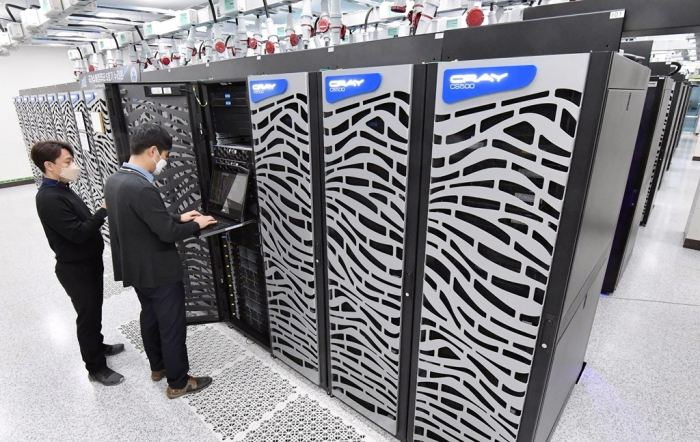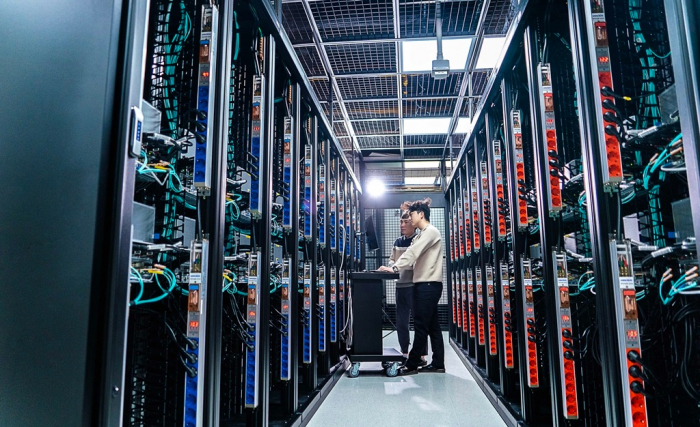Artificial intelligence
S.Korea to develop supercomputer for industrial use
This 7th supercomputer, to be built from 2025, will be able to calculate at least 1 quintillion floating point operations per second
By May 31, 2023 (Gmt+09:00)
3
Min read
Most Read
Deutsche Bank's Korea IB head quits after country head resigns


Macquarie Korea Asset Management confirms two nominees


Hanwha buys SŌĆÖpore Dyna-MacŌĆÖs stake for $73.8 mn from Keppel


Korea's Taeyoung to sell local hotel to speed up debt workout


Meritz leaves door open for an M&A, to stay shareholder friendly



South Korea is set to develop a supercomputer for industrial use as AsiaŌĆÖs fourth-largest economy lags far behind on the performance of such devices needed for super-giant artificial intelligence including ChatGPT and other future businesses.
The Ministry of Science and ICT on Tuesday unveiled a national plan for the development of high-performance computing (HPC) including the development of supercomputers and future quantum computers.
ŌĆ£HPC, infrastructure in the era of the global technology hegemony, is rapidly growing in value as a strategic asset,ŌĆØ said a ministry official.
The country plans to start the development of its seventh supercomputer in 2025 with an exaflop of performance, which can calculate at least 1 quintillion floating point operations per second. The government is currently developing the sixth model with 600 petaflops of performance that can handle 600 quadrillion floating point operations a second.
To make an AI model Chat-3 learn 175 billion parameters and 570 gigabytes of data requires 355 years of learning through a graphic processing unit. But it takes only three days for a supercomputer with an exaflop of performance to handle the task.
Currently, the US is the only country to officially operate an exaflop machine, according to the TOP500 that compiles ranks and details the 500 most powerful non-distributed computer systems in the world.
SUPERCOMPUTERS, INFRASTRUCTURE
South Korea aims to use the sixth and seventh supercomputers for the modeling and simulation service, which replaces the production of prototypes with simulation, in order to help local manufacturers cut costs.
The ministry decided to provide new open-source software required for computational fluid dynamics, structure analysis and others. It will also offer the so-called HPC-software as a service (SaaS), which supports startups of less than three years with capabilities of computational science-based information processing, consulting and modeling.
In addition, the authority is set to provide tailored computer resource support to each company based on their sector, including industries such as aerospace, autonomous driving and nuclear fusion.
The country also aims to accelerate the expansion of the infrastructure of supercomputers, given the expected rapid growth in their usage.
The government plans to establish a storage of 20 petabytes for data from large research equipment and industrial simulations while increasing its capacity by 10 petabytes every year.
The Korea Research Environment Open NETwork (KREONET), a national research and development network centered on supercomputers, was expected to transmit data of 712 petabytes this year, about five times 146 petabytes in 2021, according to the Korea Institute of Science and Technology Information (KISTI), the networkŌĆÖs operator.
The data transmission from the KREONET was predicted to nearly double to 1,335 petabytes by 2025 from this yearŌĆÖs forecast.
LAGGARD
South KoreaŌĆÖs ambition for supercomputers came as the world is fiercely racing to advance the technology on such machines with their lifecycle becoming shorter.
Samsung Electronics Co., the worldŌĆÖs largest memory chipmaker, is operating the countryŌĆÖs best supercomputer -- the SSC-21 with 25.18 petaflops of performance. But that is far behind the Frontier of the US, the global top supercomputer with 1.19 exaflops of performance. The SSC-21 ranked 20th on the latest TOP500 list, two levels lower than the end-2022.
The KISTI is also running the countryŌĆÖs fifth supercomputer Nurion with 13.9 petaflops of performance. It was operated almost at full with its monthly average utilization rate at 99.4% from January 2019 to end-2022.
The Nurion made successes in various sectors such as the development of hafnium oxide, a new raw material for the semiconductor industry, and the automation tool for organic light emitting diode (OLED) analysis. The supercomputer was also used for real-time analysis and forecast of extreme weather during air force operations.

Telecommunication carriers such as SK Telecom Co. and KT Corp. are also operating their own supercomputers.
Write to Hae-Sung Lee at ihs@hankyung.com
┬Ā
Jongwoo Cheon edited this article.
More to Read
-
 Artificial intelligenceSK Telecom doubles capacity of its AI service's supercomputer Titan
Artificial intelligenceSK Telecom doubles capacity of its AI service's supercomputer TitanFeb 13, 2023 (Gmt+09:00)
1 Min read -
 Tech, Media & TelecomS.Korea to introduce advanced supercomputer by 2024
Tech, Media & TelecomS.Korea to introduce advanced supercomputer by 2024Sep 28, 2022 (Gmt+09:00)
1 Min read
Comment 0
LOG IN


